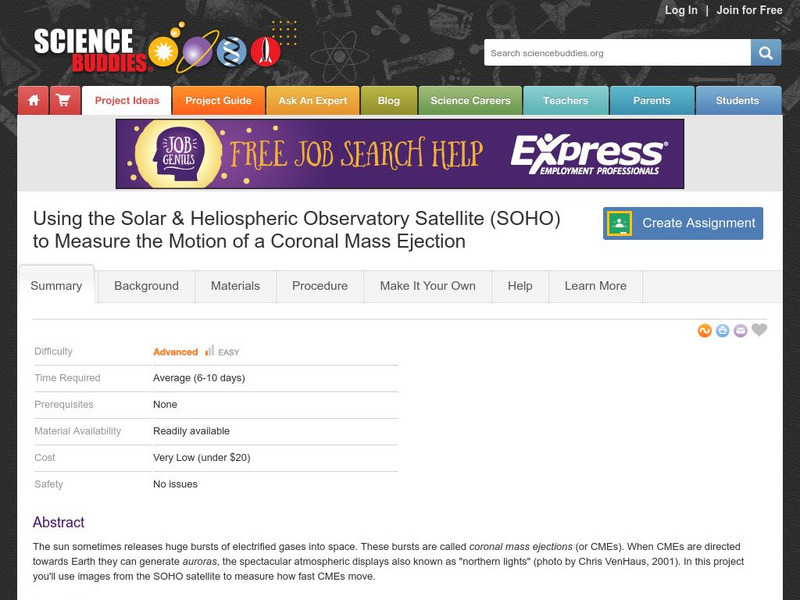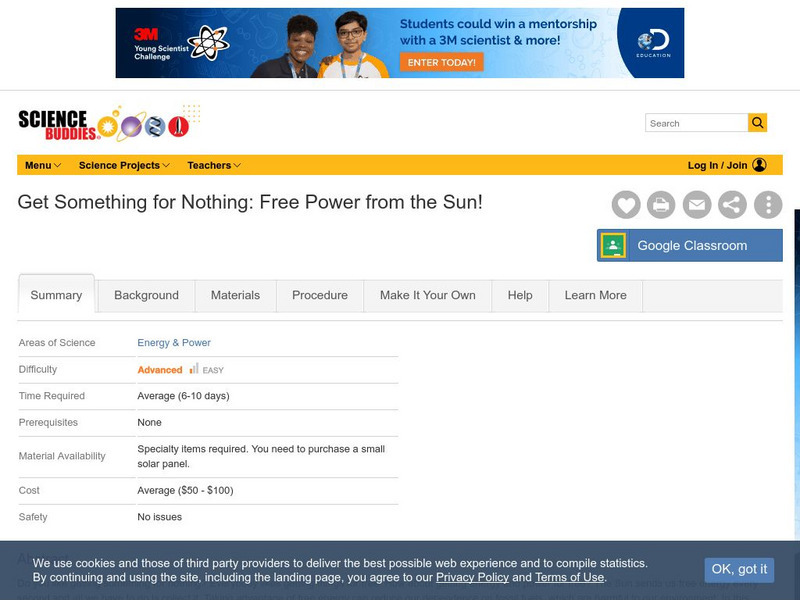Curated OER
Energy
In this energy instructional activity, students complete a crossword puzzle by determining the terms associated with the 20 given clues. Students review alternative forms of energy in this instructional activity.
Curated OER
Type of Energy - Dot to Dot Puzzles
In this energy learning exercise, students connect the dots to complete pictures of three types of energy that include solar energy, static energy, and stored energy. They color the page and draw other examples of energy in a box at the...
Curated OER
Solar Energy Word Search
In this word search worksheet, students single out fifty words related to solar energy. Examples include spectrum, thermal, and focal point.
Curated OER
How the Amount of Solar Energy Absorbed by the Earth is Dependent Upon the Earth's Position
Students investigate the angle of light and how it faces the earth. They conduct a series of investigations with the following two objectives. Students determine if the angle of light is a factor in the absorption of heat. They correlate...
Curated OER
Renewable Energy
Pupils identify how to study renewable energy from the standpoint of a news reporter or a concerned citizen. Then they approach art in a fun way through a journalism project that includes create a brochure for display. Students also...
Curated OER
Solar Car activity
Students study the basic concept of solar energy. They build a working solar car. Students comprehend how solar energy can be produced via a solar panel. They examine the physics that describe how a solar panel works.
Curated OER
A Cosmic Cafeteria
Students indentify and differentiate between transit and surface food systems. Students measure energy that is released by various foods. Students compare and contrast cooking with solar energy on earth and what they might have learned...
Curated OER
Star Power! Discovering the Power of Sunlight
Students estimate the energy output of the sun. They estimate how much power sunlight the sunlight provides to the earth. They build a simple device to measure the amount of solar radiation the earth receives from the sun.
Curated OER
TE Activity: Racing with the Sun - Creating a Solar Car
Middle schoolers use a purchased kit to build a solar powered car. They connect a solar photovoltaic panel to a motor which runs the car forward and backward. They determine how to wire the car to move in both directions.
Curated OER
It's All In The Surface: The Effects Of Color & Texture On The Ability Of A Surface To Absorb Solar Energy
Ninth graders examine how dark surfaces absorb more light than light surfaces. They perform an experiment that compares various surfaces abilities to absorb heat, then record and analyze the results.
Curated OER
Reflective Solar Cooker
Students build and use a reflective solar cooker to cook marshmallows.
Curated OER
What Stores Solar Energy Best?
Students discuss reasons and methods for keeping a home warm in winter and cool in summer as examples of energy storage. Students participate in a solar energy experiment.
Concord Consortium
Concord Consortium: Stem Resources: Build and Test a Model Solar House
A learning unit with instructions on how to build a cardboard model house, and explore the effectiveness of a furnace vs. solar heating. The unit is in PDF format.
National Academies of Sciences, Engineering, and Medicine
The National Academies: Our Energy Sources
The many sources of energy production in the United States are described in this overview. Included are traditional sources, renewable sources, and new energy production technologies.
eSchool Today
E School Today: Renewable Energy Sources
Learn what renewable energy is, the different types, and why it's important to conserve energy.
American Geosciences Institute
American Geosciences Institute: Energy
Seven hands-on lessons module where students learn about energy. These inquiry-based explorations investigate where energy resources come from and how they are converted into electricity, how fossil fuels form, the importance of...
PBS
Pbs Learning Media: A Different Kind of Fuel
In this segment from Curious, learn about creating energy from solar rays to meet the growing energy needs of the world. [6:09]
PBS
Pbs Learning Media: Solar House
In this What's Up in the Environment? video segment, an electrical engineer in Virginia and his 13-year-old son explain how they produce electricity in their home. [3:58]
Science Buddies
Science Buddies: Build Your Own Helio Tracker That Turns With the Sun
In this science fair project, design and build a mechanical sunflower device that faces the Sun as the sun moves through the sky. By harnessing solar energy, your sun tracker should follow the movement of the sun.
Science Buddies
Science Buddies: A Matter of Degrees: Tilt of Earth's Axis Affects the Seasons
In this science fair project, use a globe and a heat lamp to investigate how the angle of the Sun affects global warming. This project includes the objective, background questions, a list of all the materials you'll need, and the...
Science Buddies
Science Buddies: Are You in Hot Water? Use Solar Energy to Heat Your Own Water
The goal of this science fair project is to build batch solar collectors from different colors of plastic bags and see which collector is the most efficient in heating water.
Science Buddies
Science Buddies: Observatory Satellite Measures Motion of Coronal Mass Ejection
The sun sometimes releases huge bursts of electrified gases into space. These bursts are called coronal mass ejections (or CMEs). When CMEs are directed towards Earth they can generate auroras, the spectacular atmospheric displays also...
Science Buddies
Science Buddies: Get Something for Nothing: Free Power From the Sun!
Taking advantage of free energy can reduce our dependence on fossil fuels, which are harmful to our environment. In this science fair project, you will work with a solar panel, which is a collector of free energy, and investigate how...
Science Buddies
Science Buddies: Solar Speedway
Solar power is hot these days. Gleaming, black solar panels soak up rays on more and more rooftops of homes and businesses providing a clean, alternative source of heat and electricity. You might guess that different times of the day...






















